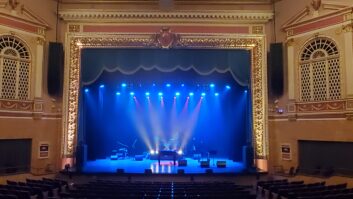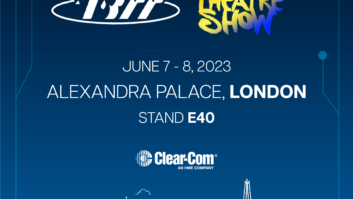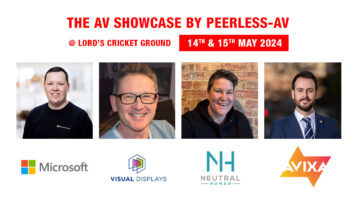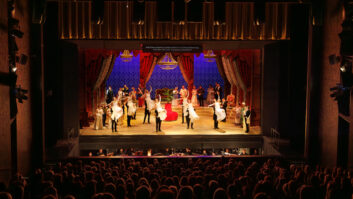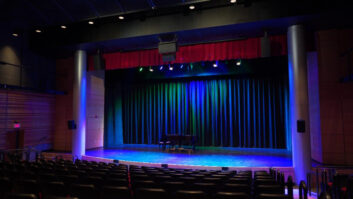Paddy Baker visits the Netherlands’ only opera house, and finds an operation that uses some unusual technology, plus automation and in-house expertise, to ensure that the show goes on
Built in 1986 along with the adjoining City Hall, the 1,600-capacity Amsterdam Music Theatre is one of the largest theatres in Holland, as well as being the only opera house in the Netherlands. The theatre is home to two national companies: the Dutch National Opera puts on 12 productions each year, and the Dutch National Ballet 10. There are also eight to 10 productions from visiting companies annually. This means that at any given time, a production will be in rehearsal during the daytime while another is performed in the evening. So each day (seven days per week) begins with building the set for rehearsals (which run from 11:00 until 3:00). After that, the set is built for that night’s performance, which starts at 8:00, and then taken down afterwards.
The stage area can be thought of as being divided into four squares: one containing the on-stage production and three others. “As long as there is one square free, we can move everything around,” explains Pieter Huijgen, deputy head of the lighting department. The movement of sets is made easier by the use of pneumatic floors, which ‘hover’ on air cushions and are controlled by an automatic guided vehicle (AGV) system to millimetre precision. There are five such floor pieces, each measuring 16.2m by 2.7m and weighing six tonnes. Although the floors date from the theatre’s opening, there are still only a handful of theatres that have them: and, says Huijgen, this is the only theatre in which they are automated.
In fact, automation is something of a theme here. “Our vision is that every single lighting fixture in the theatre that you can’t reach by hand has to be automated,” he continues. “Otherwise the time taken to refocus the lights is huge for these kinds of productions. It saves a lot of time: we only have between 4:00 and 7:00 to rebuild the production – rerig it, focus the lights and check lighting cues.” Fortunately, this vision is being realised: the last automated overhead fixtures have been installed.
@page_break@
Repertoire setting
To enable the stage to be used by different productions on a given day, many of the spotlights have fixed positions – known as the repertoire setting. These are positioned on a number of fixed and mobile proscenia, bridges, towers and ladders. The four mobile lighting bridges above the stage each contain 10 Licht-Technik 2kW yokes for backlighting, eight ETC Source Four Revolution moving heads as crosslights and three High End X-Spots.
The most recent additions to the lighting inventory – supplied by Lightco, among others – include a number of automated fixtures, including more ETC Revolutions, all equipped with shutter modules, and Vari-Lite VL 1000AS arc shutter luminaires and VL 3500Q spotlights – quiet operation being an important feature of the latter. Also recently purchased were 80 Rainbow colour scrollers for automated colour scrolling in the ballet towers. The theatre prefers Rosco Supergel for its filtering, and the lighting department makes its own gelstrings.
Control of the flybars and hoists – all 164 of them, is via Unican OpenCue software (specially written for the theatre after the original software company ceased trading). This also looks after stage revolves and stage lifts. The power cables for the flybars are on cable reels that provide a constant tension; like the floating floors, these items of equipment have their origins in the world of harbour technology.
Nearly all lighting maintenance is carried out by the 36-strong lighting department. In addition, the stage maintenance team can test and repair the flybar system. “The response time is just minutes,” says Huijgen. “We need all our technical equipment to do the show – we can’t say ‘Sorry, not tonight’.”
The lighting is controlled by a Transtechnik Prima NTX console, communicating with dimmers and servers via Ethernet. However, a more popular alternative to the board itself is Transtechnik’s Libra touchscreen system, which is user-configurable – so lighting operators can build their own virtual lighting board.
The Libra system can produce a graphic filter for show-specific lighting fixtures. Huijgen explains: “During rehearsals, the lighting designer sits in the auditorium with the other artistic people. Rather than giving him a plan with all the fixtures in and numbers, we give him this view of the extra lights and the whole lighting repertory – he can see whether a fixture is being used or not. If it’s used, the value, position and colour are shown; so if the lighting designer wonders where the red light upstage left is coming from, he can look for a red button and then ask for, say, channel 845 to be turned down. Lighting designers love to work with this system as it’s much more intuitive.”
@page_break@
Beltpack solution
The stage manager’s desk – built by Salzbrenner Stagetec – combines a number of technologies. A Clear-Com intercom system allows voice communication with up to 40 wearers of wireless beltpacks, sorted into call groups for different areas. Also visible on the selection of screens are lighting cues, flybar cues, and three views of the stage from remote cameras.
A clever solution to intercom beltpack battery management has been developed in house. The previous system of having someone in charge of handing out beltpacks was quite time-consuming, and it was hard to keep track of the condition of the batteries.
“So we made a system with lockers,” explains Huijgen. “All the guys have an RFID entrance pass. They just hold it up to a sensor, a locker opens, they take out a beltpack, remove the charge connector, and work with it for eight hours. When the battery is empty, they return the beltpack, connect the charge connector, then the door locks and they can get another one out.”
He continues: “On each locker, you can see the charging time of the battery. When there’s a problem with a beltpack, you can scan it, enter some details regarding the error on the keyboard, return it and dock it. The system automatically sends an email to the guy who manages the system so he knows which beltpacks are down.”
Spreading the word
The in-house AV and communications department carries out audio and video recording, video editing for DVDs, content creation for on-stage projections and website production. Many of the operas are broadcast on TV and radio; from next season, a new studio in the theatre will handle audio for radio broadcast. There is also a 5.1 audio recording studio and a video-editing studio.
For multitrack recording of performances, the theatre has used a Pyramix digital audio workstation from Merging Technologies for a number of years; recordings are then edited and mixed, both for commercial CD and DVD releases and for in-house use.
A lot of productions at the Amsterdam Music Theatre use pre-recorded music and other audio. Previously, making changes to this during the rehearsal process was a painstaking business: notes were made during rehearsals, changes were made offline and brought back to the stage at another time.
To simplify this process, the Ovation media and show sequencer, also from Merging, was brought on board. Ovation is designed to handle playback of audio and control signals, mixing of playback material and live inputs, and local and remote system control.
“Ovation integrates well with Pyramix and it’s very reliable,” says Frederik Furnee, studio master in the theatre’s AV department. “We were excited at the prospect of not burning performance CDs any more, having the ability to make immediate corrections and changes of edits and audio files, along with the possibility of easily playing multi-track audio files in the theatre – not to mention the huge increase in the quality of sound.”
Ovation features integrated editing with Pyramix, so it is possible to listen to the edits through the same outputs as the Ovation. During rehearsals the team can open an audio cue in the Pyramix timeline, make edits and add more sounds to the multitrack, then send the cue back to Ovation without having to render or mixdown – saving a lot of time.
The Ovation timecode can be used for more than audio, explains Huijgen: “In one of the ballet pieces we did, video projection and lighting were synced to the timecode – everything was executed by the timecode coming out of the system.”
For central storage of all the media that is used and created, the theatre uses Merging’s Luxor Media Server, which is optimised for network streaming. Shows are generally stored and edited on the Luxor, then consolidated onto the Ovation media drive when it is decided to have the files stored locally.
@page_break@
Audio consoles
All audio signals travel over a fibre optic system that runs through the theatre. There are three audio desks, all from Stagetec. The largest, an Aurus (64 channels plus another 64 back-up channels) is in the recording studio, where audio from the stage is recorded and mixed. There is a smaller on-air console in the new studio C, which is to be used for radio broadcasts, and a Stagetec Crescendo desk front of house.
“It’s good just to have one system, where we can access all the sources of audio – everyone can select the audio material they want to use. It’s transparent and you have very little conversion – it’s a very professional system, one of the best for classical music, I think,” says Jorik de Beer, AVC studio technician.
Sound reinforcement in the auditorium is carried out by an Apogee system, which is several years old but is well received. Audiences at the theatre’s occasional film screenings have said that the sound is better than at the cinema.
The natural acoustic in the auditorium is enhanced by a Lexicon Lares system, which analyses the audio in the hall and adds reverb; this can be adjusted for every production. “Without the system the ambience is too dry,” explains Huijgen. “But you don’t notice the system until you switch it off.”
On the visual side, the theatre’s inventory includes two Barco R-12+ projectors and two Hippotizer HD media servers. One of the projectors is used for the opera surtitle system, while the other can be moved around to suit production requirements. If more projectors are needed, they are hired in. “We just did a ballet piece with a 180º projection, done with seven projectors,” explains Huijgen. “And at the same time we did Eugene Onegin with two projectors.”
Overall, one can’t help but be impressed by the way the Amsterdam Music Theatre does things. It’s a very self-reliant operation, with plenty of in-house expertise not only to keep things running smoothly day to day, but also to engineer solutions that either address the requirements of specific productions or improve existing operations. As Huijgen puts it: “One of the nice things about this theatre is that we’re self supporting. Whatever we need to do, we’ve got the experience, and we’ve got the people to do it.”

